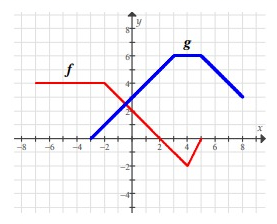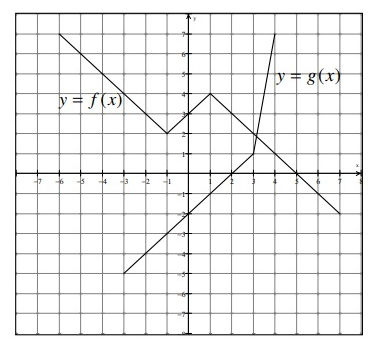EVALUATING COMPOSITION OF FUNCTIONS FROM A GRAPH WORKSHEET
Answer the following, using the graph below.

Problem 1 :
(a) g(2) (b) f(g(2)) (c) f(2) (d) g(f(2))
Problem 2 :
(a) g(0) (b) f(g(0)) (c) f(0) (d) g(f(0))
Problem 3 :
(a) (f ∘ g)(-3) (b) (g ∘ f)(-3)
Problem 4 :
(a) (f ∘ g)(-1) (b) (g ∘ f)(-1)
Problem 5 :
(a) (f ∘ f)(3) (b) (g ∘ g)(-2)
Answer Key
1) a) g(2) = 5 b) f (g(2)) = f(5) c) f(2) = 0
d) g (f(2)) = 3.
2) a) g(0)) = 3 b) f (g(0)) is -1 c) f(0)) = 2
d) g (f(0)) = 5
3) a) (f ∘ g)(-3) = 2 b) (g ∘ f)(-3) = 6
4) a) (f ∘ g)(-1) = 5 b) (g ∘ f)(-1) = 5
5) a) (f ∘ f)(3) = 3 b) (g ∘ g)(-2) = 4
Problem 1 :
Refer to the graph to complete the statements below.

a) (f + g)(-3) = ______ Solution
b) (f · g)(2) = ______ Solution
c) (f/g)(-1) = ______ Solution
d) (f ∘ g)(3) = ______ Solution
e) g-1(-4) = ______ Solution
f) Evaluate (f ∘ f)(2) ______ Solution
g) Evaluate g(f(g(1))) ______ Solution
h) State the domain of f + g _____ Solution
i) State the domain of f/g. ______ Solution
j) Evaluate (f(3))3 - 4g(-2) ______ Solution
k) For what value(s) is f(x) = 3? _______ Solution
Answer Key
1) a) (f + g)(-3) = -1
b) (f · g)(2) = 0
c) (f/g)(-1) = 2/(-3)
d) (f ∘ g)(3) = 4
e) g(x) = -4
f) (f ∘ f)(2) = 2
g) g(f(g(1))) = 0
h) domain of f + g = [-3, 4]
i) domain of f/g = [-3, 1] u (3, 4]
j) (f(3))3 - 4g(-2) = 24
k) For what value(s) is f(x) = 3?
-2, 0 and 2
Recent Articles
-
Finding Range of Values Inequality Problems
May 21, 24 08:51 PM
Finding Range of Values Inequality Problems -
Solving Two Step Inequality Word Problems
May 21, 24 08:51 AM
Solving Two Step Inequality Word Problems -
Exponential Function Context and Data Modeling
May 20, 24 10:45 PM
Exponential Function Context and Data Modeling